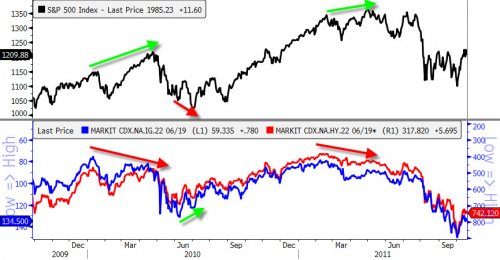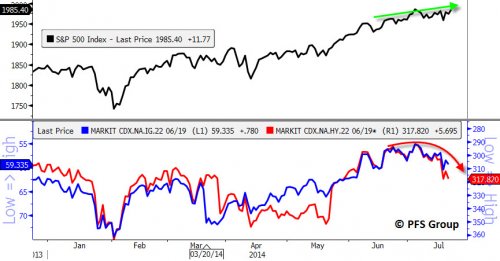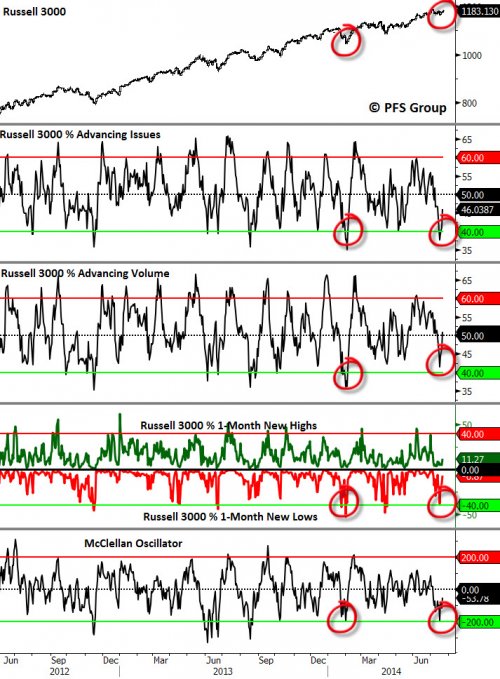- Divergence with small cap stocks and junk bonds persists
- Credit spreads widening suggests increasing short-term financial stress
- Markets oversold. How risk areas react will be telling
One of the most widely followed market theories is Dow Theory, which has been around for more than 100 years. The essence of Dow Theory is to focus on confirmations or non-confirmations between the Dow Jones Transportation Average and the DJ Industrial Average for assessing market trends and reversals. If one of the indexes breaks out to a new high while the other does not, we have a non-confirmation and the potential for a market reversal.
Similar to Dow Theory I like to look for confirmation between the stock market and the credit markets. When one market does not confirm the other, caution is advised. Typically I’ve found that when there is a divergence between the equity markets and the credit markets it is usually the credit markets that have it right. I believe this is the case because the average investor is far less invested in the credit markets than the equity markets and sadly the track record of the average investor is quite poor. As seen below, over the last 20 years the average investor’s annualized return barely beat the rate of inflation and underperformed every major asset class.

Source: JPM, Market Insights 3Q 2014
When I see the credit markets not confirming the equity markets I take notice because the credit markets tend to lead the stock market at major turning points. The best example of this can be seen during the last two major turning points which were the 2007 top and the 2009 bottom. The Bloomberg Financial Conditions Index, which is a composite of credit spreads from the money market, bond market, and equity markets peaked well before the S&P 500 peaked in October of 2007 and also bottomed well before the S&P 500 bottomed in March of 2009.
As seen below, the Bloomberg US Financial Conditions Index peaked in early 2007 and put in a series of lower highs while the S&P 500 kept marching higher. Similarly, the credit markets put in a “V-spike” bottom in October 2008 while the equity markets didn’t bottom until nearly half a year later.

Given how well the credit markets warned of the last two major turning points in the market I respect the message of the credit markets over the stock market when the two do not confirm each other, as they are currently. The S&P 500 is sitting near all-time highs while the Bloomberg Financial Conditions Index witnessed a sharp decline in early July and has only recovered half of its decline over the last week.
Outside of the present case, the most recent non-confirmation between the Bloomberg Financial Conditions Index and the S&P 500 was back in January when the S&P 500 was making new highs while the Financial Conditions Index was not, which foreshadowed the 6% January to February decline.

Another credit indicator I’ve learned to respect is credit default swaps (CDS) on investment grade and high yield bond (AKA: “Junk Bond”) indices. The CDS on both corporate bond indices were great warning signals for the 2010 and 2011 tops which are shown below. The CDS for investment grade bonds are shown in blue and inverted for directional similarity as are the CDS for junk bonds shown in red. You can see that the two CDS indices failed to confirm the new high in the S&P 500 set in April 2010 and warned of a coming correction.
Conversely, the credit markets failed to confirm the low set by the S&P 500 in July 2010 and setup a positive divergence as the markets were putting in a bottom. Like the 2010 top, the CDS on the corporate bonds indices failed to confirm the new high in the S&P 500 in May 2011 and warned of a coming correction.

In the present case, the S&P 500 has been grinding higher over the last month while the CDS on corporate bonds have been eroding, suggesting caution regarding the market’s recent strength.

Looking further into the corporate bond world provides more cause for concern as junk bonds are beginning to underperform investment grade bonds as investors move up the safety scale. Looking at the iBoxx High Yield Index total return relative to the iBoxx Investment Grade Index total return (red line, second panel) shows that the market tends to perform best when liquidity is most abundant and junk bonds are outperforming investment grade bonds. Also shown in the bottom panel in blue is the Russell 2000 Small Cap Index which also has been lagging behind the large cap S&P 500 Index. So taken collectively, we appear to be witnessing investor departure from risk assets and into safer assets like large cap stocks over small cap stocks or investment grade bonds over junk bonds. It appears this shift in safety preferences appears to have occurred right around the time of the Fed’s announcement that it was “tapering” its asset purchases at its December 18th 2013 FOMC meeting.

The weakness in small cap stocks and junk bonds was highlighted in my article last week (“The First Victims of the End of QE”) and this trend of receding market liquidity and an investor shift towards safety is likely occurring in anticipation of the end of QE. Does this portend rough water ahead for the market? It could, but I wouldn’t jump the gun just yet.
Remember the mid-term election cycle that was supposed to see the stock market peak in the spring and then sell off all summer? Many professional money managers and investment strategists at major Wall St. banks were positioned for the supposed double-digit correction by raising cash and advising clients to do so. We never did get the double-digit correction and the mid-term election cycle did not pan out as I suggested it wouldn’t (“Mid-term Election Cycle Forecasts April Market Peak”) as the economy was too strong and the Fed was still printing billions of dollars, something it hadn’t done in any previous mid-term election year. There was such a consensus for the mid-term election cycle to pan out that it reminds me of Bob Farrell’s rule number 9 of his 10 career lessons: “When all the experts and forecasts agree – something else is going to happen.”
There was plenty of cash on the sidelines from everyone positioned for the mid-term election year cycle to play out and when it didn’t and the economy accelerated they moved back into the market. However, given their risk adverse bias towards the market, these same investors and strategists likely went reluctantly back into the market for fear of being left behind but likely did so by buying safer assets like large blue chip stocks and investment grade bonds. This likely explains the underperformance of risky assets in 2014. However, if there is something more sinister brewing beneath the surface beyond my reasoning then I would expect to see junk bonds and small cap stocks continue to underperform the market as they have at significant market peaks.
The market is currently more oversold than it looks given the strength in large cap issues, which masks the weakness in the thousands of smaller cap stocks that carry much less market significance. I look at the Russell 3000, which has 3000 stocks within it for a very broad view of the market, and currently my technical indicators are coming off the most oversold condition since the February lows. It will be very important to see how small cap stocks and junk bonds react to this oversold condition.
Should both areas of the market continue to remain weak then there really is something brewing beneath the surface in which a bigger correction may be in store. However, should these areas rally the all-clear will have been given as these negative divergences are removed and it likely was just too many strategists and investors preparing for the mid-term election cycle that never was.
Summary:
The riskiest areas of the market—small cap stocks and junk bonds—have been underperforming safer investments like large cap stocks and investment grade bonds, all year. The underperformance first appeared late in 2013 as the Fed began its plans to slow its asset purchases by “tapering” $10B a month. This loss in liquidity appears to have reduced animal spirits in the market and also was likely amplified by investor and strategist fears of the typical mid-term election cycle correction playing out as investors and money managers had above average levels of cash earlier in the year. As the markets continue to push to new records these same managers have come back to the market but they continue to maintain their distrust as they’ve allocated their cash to safer investments like large cap stocks and investment grade bonds.
Currently, small cap stocks and junk bonds are oversold and how they react to this oversold condition should shed light if there is something more serious occurring in which we may be in store for a steeper correction than what we’ve seen over the last year. If they fail to participate on the upside and credit spreads continue to widen then risk management will be crucial in the weeks and months ahead. Given the strength in the economy and strong earnings season it doesn’t appear that dark clouds are building, but as always time will tell.
